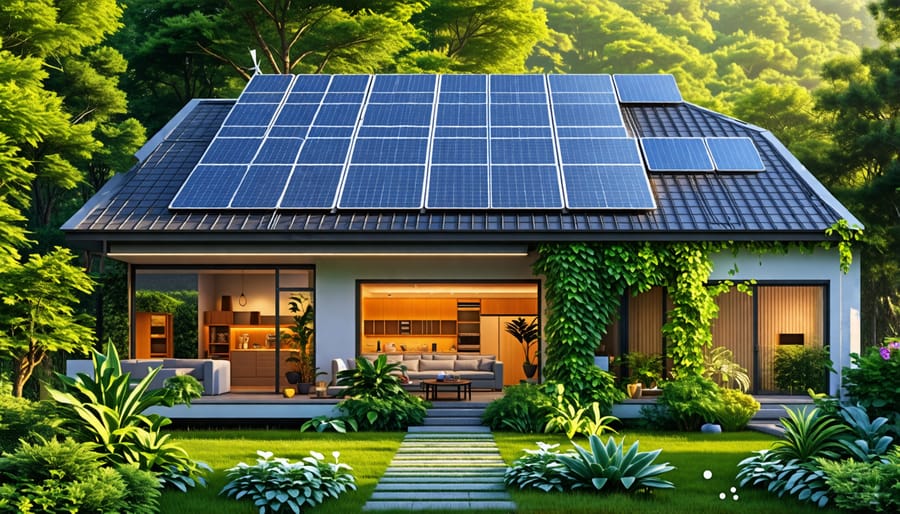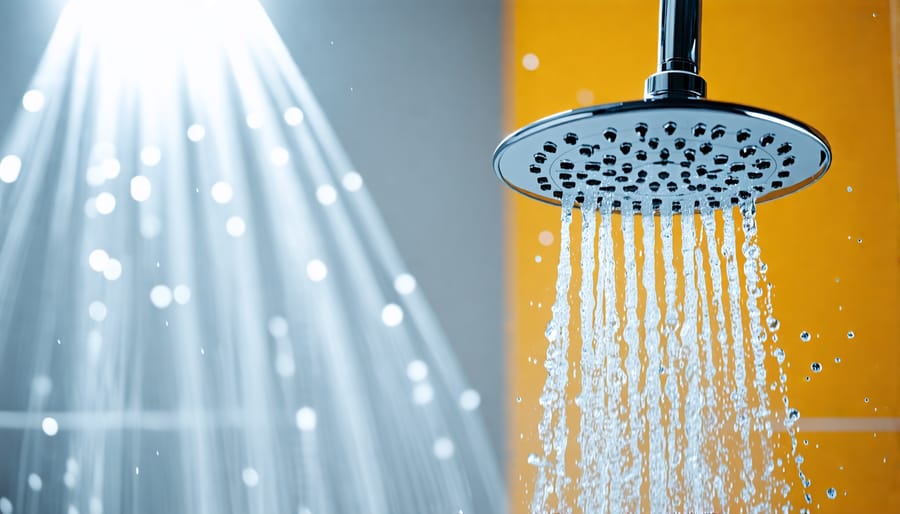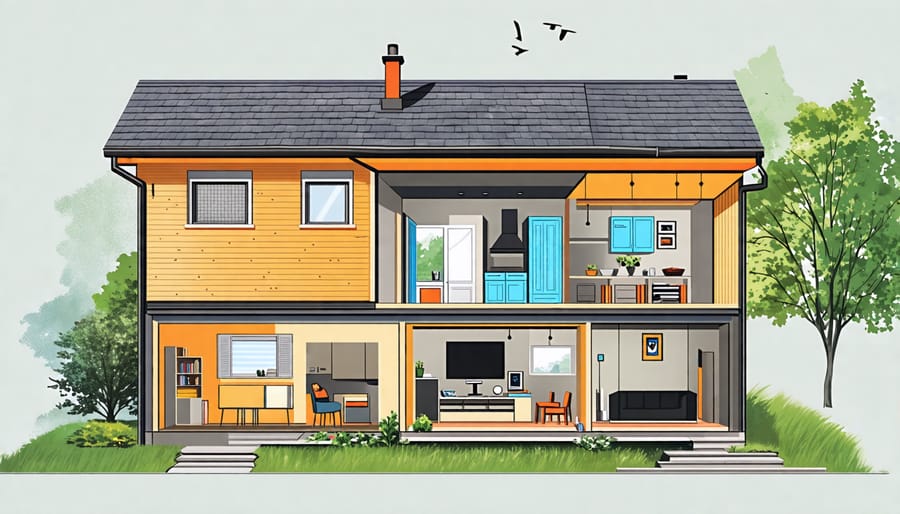
9 Effortless Home Upgrades That Slash Your Eco Footprint
Confront the looming environmental crisis head-on with innovative sustainability solutions that tackle the root causes of ecological degradation. Harness renewable energy technologies, adopt circular economy principles, and invest in nature-based solutions to drastically reduce greenhouse gas emissions, minimize waste, and restore vital ecosystems. By embracing a holistic, multifaceted approach that combines cutting-edge science, forward-thinking policies, and broad societal engagement, we can chart a course towards a more resilient, equitable, and sustainable future for all.

Switch to Energy-Efficient Lighting
Switching to energy-efficient lighting is a simple yet impactful way to reduce your home’s energy consumption and lower your utility bills. LED (light-emitting diode) and CFL (compact fluorescent lamp) bulbs are the two most popular types of energy-efficient lighting. These bulbs use significantly less energy than traditional incandescent bulbs while providing the same amount of light output.
When choosing LED or CFL bulbs, consider the brightness (measured in lumens), color temperature (warm or cool), and the bulb’s intended use. LED bulbs are ideal for frequently used areas like living rooms, kitchens, and bathrooms, as they have a longer lifespan and are more durable. CFL bulbs work well in less frequently used spaces, such as closets or guest rooms, as they take a few moments to reach full brightness.
To maximize energy savings, replace your most-used bulbs first, such as those in ceiling fixtures, table lamps, and outdoor lighting. Don’t forget about specialty bulbs in recessed lighting, chandeliers, and task lamps. As you replace bulbs, be sure to dispose of old CFL bulbs properly, as they contain a small amount of mercury.
By making the switch to energy-efficient lighting, you’ll not only save money on your energy bills but also contribute to a more sustainable future by reducing your home’s carbon footprint.
Upgrade to Water-Saving Fixtures
Upgrading to water-saving fixtures is an easy and effective way to conserve water in your home. Low-flow faucets and showerheads reduce water usage by limiting the flow rate without sacrificing performance. These fixtures typically use aerators or specialized designs to maintain water pressure while using less water per minute. Dual-flush toilets feature two flush options – a low-volume flush for liquid waste and a higher-volume flush for solid waste. This allows you to save water on the majority of flushes while still providing ample water when needed.
Installing these water-saving fixtures is a straightforward DIY project for most homeowners. Start by turning off the water supply to the existing fixture. Remove the old faucet, showerhead, or toilet, taking care to properly dispose of any debris. Clean the installation area thoroughly before proceeding. Follow the manufacturer’s instructions to install the new low-flow or dual-flush fixture, ensuring a tight seal to prevent leaks. Turn the water supply back on and test the new fixture for proper operation and any leaks. With a few simple tools and a bit of know-how, you can upgrade your home’s fixtures to save water and money on utility bills.

Invest in Energy-Efficient Appliances
Investing in Energy Star certified appliances is a smart move for homeowners looking to reduce their energy consumption and utility bills. These appliances have been independently certified to meet strict energy efficiency guidelines set by the U.S. Environmental Protection Agency. By using less energy, Energy Star appliances help lower greenhouse gas emissions and protect the environment.
When shopping for new appliances, look for the Energy Star label on refrigerators, dishwashers, washing machines, dryers, and even electronics like televisions and computers. While the upfront cost may be slightly higher than non-certified models, the long-term energy savings often make up for the initial investment.
For those on a tight budget, consider starting with smaller appliances like energy-efficient light bulbs or a programmable thermostat. These affordable upgrades can still make a noticeable difference in your energy consumption. As your budget allows, gradually replace larger appliances with their Energy Star certified counterparts.
If you’re planning a kitchen renovation, prioritize appliances that use the most energy, such as the refrigerator and dishwasher. An Energy Star certified refrigerator can save you hundreds of dollars over its lifetime, while an efficient dishwasher can significantly reduce water and energy use.
When replacing your washer and dryer, look for models with high energy efficiency ratings and features like moisture sensors that automatically adjust drying time. These smart features not only save energy but also help extend the life of your clothes by preventing over-drying.
By investing in Energy Star certified appliances, you’re not only helping the environment but also making a wise financial decision that will pay off in the long run through reduced utility costs and a more sustainable home.

Improve Insulation and Weatherstripping
Proper insulation and weatherstripping are essential for reducing energy waste in your home. Insulation helps keep heat inside during winter and outside during summer, while sealing air leaks prevents drafts and maintains a comfortable indoor temperature. To get started, inspect your home for gaps around windows, doors, electrical outlets, and plumbing fixtures. Use caulk to fill small cracks and gaps, and apply weatherstripping around movable components like door and window frames.
For windows, consider installing foam tape weatherstripping or window film for added insulation. Door sweeps can be attached to the bottom of doors to prevent air leaks. Don’t forget about insulating your attic, walls, and floors, which can be done using materials like fiberglass batts, cellulose, or spray foam. These DIY weatherstripping and insulation projects are relatively easy to complete and can result in significant energy savings over time. Plus, a well-insulated home is more comfortable year-round. By taking steps to improve your home’s insulation and seal air leaks, you’ll be doing your part to reduce energy waste and create a more sustainable living space.
Install a Programmable or Smart Thermostat
Installing a programmable or smart thermostat is an effective way to optimize your home’s HVAC efficiency. These devices allow you to set schedules that automatically adjust the temperature based on your daily routines and preferences. By reducing energy waste when you’re away or sleeping, you can significantly lower your utility bills and environmental impact.
When setting up your thermostat, consider factors like your work schedule, sleep habits, and seasonal changes. Program the device to reduce heating or cooling during periods when it’s not needed, such as when everyone is at work or school. Many smart thermostats also offer features like geofencing, which uses your phone’s location to detect when you’re away and adjusts the temperature accordingly.
To maximize energy savings, aim to set your thermostat a few degrees lower in winter and higher in summer. Each degree can make a noticeable difference in your HVAC system’s energy consumption. Additionally, regularly maintain your HVAC system to ensure it’s running efficiently and not working harder than necessary to maintain your desired temperature.
Choose Sustainable Furniture and Decor
When furnishing and decorating your home, opting for sustainable materials and environmentally-friendly manufacturing processes can significantly reduce your ecological footprint. Sustainable materials are those that are renewable, biodegradable, or recycled, and their production minimizes waste and pollution. Look for furniture made from reclaimed wood, which gives new life to timber that would otherwise end up in landfills. Bamboo is another excellent choice, as it grows quickly and requires fewer resources than traditional hardwoods. When selecting fabrics for upholstery, curtains, or bedding, choose organic options like cotton, linen, or hemp that are grown without harmful pesticides and chemicals. Additionally, seek out manufacturers who prioritize eco-friendly practices, such as using low-VOC finishes, minimizing packaging waste, and implementing energy-efficient production methods. By making conscious choices about the materials and production processes behind your furniture and decor, you can create a beautiful, comfortable home that also contributes to a healthier planet.
Add Interior Plants for Natural Air Filtration
Houseplants not only add a touch of nature to your home decor but also act as natural air purifiers. Many common indoor plants are effective at removing toxins like formaldehyde, benzene, and ammonia from the air through their leaves and roots. Houseplants remove toxins by absorbing them and breaking them down, improving the overall air quality in your living spaces.
Some of the best air-purifying plants include snake plants, spider plants, peace lilies, and pothos. These low-maintenance options thrive in various light conditions and are easy to care for, making them perfect for beginners. Incorporate a mix of these plants throughout your home, placing them in rooms where you spend the most time for maximum air-purifying benefits. Not only will you breathe easier, but you’ll also enjoy the calming, natural ambiance they provide.
Create Recycling and Composting Stations
Proper waste sorting is a crucial part of creating a more sustainable home. By setting up dedicated recycling and composting stations, you can make it easy for everyone in your household to properly dispose of different types of waste. When designing your stations, focus on making them attractive and well-organized. Use clear labels and color-coding to designate different bins for paper, plastic, glass, metal, and compost. Consider investing in stylish, matching containers that fit your home’s aesthetic. Position your stations in convenient locations, such as the kitchen, garage, or utility room, to encourage consistent use. To further boost your composting efforts, you can even create a small indoor compost bin using a countertop container or under-sink system. By making waste sorting an intuitive and visually appealing part of your daily routine, you’ll be well on your way to reducing your environmental impact at home.
Conclusion
In conclusion, these nine sustainable home upgrades collectively create a more sustainable home by reducing energy and water consumption, improving air quality, utilizing eco-friendly materials, and minimizing waste. By implementing even just a few of these changes, you can significantly lower your environmental impact while also enhancing the comfort and efficiency of your living space. Don’t feel overwhelmed by trying to tackle all nine upgrades at once; start with one change that resonates with you and gradually incorporate additional sustainable practices over time. Every step you take, no matter how small, contributes to a greener future for both your home and the planet.
